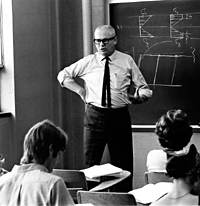A memorial service at 4 p.m. today will honor Charles L. Best, professor emeritus of engineering, whose distinguished Lafayette career as teacher, mentor, and scholar spanned four decades.
Best died Monday, June 21. He is survived by sons Charles Jr., Timothy, and William, also a former member of the Lafayette faculty. His wife, the former Margaret E. “Peggy” Backes, died in 1993.
Best joined the Lafayette faculty in 1948 and taught at the College continuously with the exception of one three-year period. He retired in 1989 as John Markle Professor of Engineering Science and the senior member of the faculty, as well as a six-time recipient of faculty awards. He was responsible for developing a course for non-engineering students that attracted nationwide recognition and oversaw creation of the bachelor of arts in engineering program. He also was Lafayette’s first lacrosse coach.
Born June 25, 1925, in Brooklyn, Best graduated from Brooklyn Technical High School in 1942 and earned a B.S. from Princeton in 1945. He went on to earn an M.S. at Brooklyn Polytechnic Institute in 1954 and a Ph.D. from Virginia Polytechnic Institute in 1962.
Best’s career began in World War II, when he served in the Navy’s V-12 program from 1944-45. He was employed from 1945-46 as a stress analyst at Kellett Aircraft Co., Swarthmore, Pa. He served in 1946 as a research assistant at Princeton Aero Labs, Princeton, N.J., and was instructor of mathematics from 1946-1948 at Mohawk College, Utica, N.Y.
Lafayette employed Best as instructor of mechanics from 1948-51. After a hiatus as materials test engineer at the Johns Manville Corporation’s research center in Manville, N.J., he returned to the College in 1954 as associate professor of mechanics and engineering fundamentals. He was promoted to full professor in 1966 and became department head of engineering science in 1975.
Best coauthored Analytical Mechanics for Engineers in 1965 with William G. McLean, director of engineering at Lafayette from 1962-1975, and Applied FORTRAN for Engineering and Science in 1982 with James P. Schwar ’57, professor emeritus of computer science. He wrote two more books, Introduction to the History of Technology and Schaum Outline Series: Mechanics, and published papers on computer programming and the history of technology.
He received the Thomas Roy and Lura Forrest Jones Faculty Lecture Award in 1960, the Thomas Roy and Lura Forrest Jones Award for superior teaching and scholarly contributions in 1967, and the Christian R. and Mary Lindback Award for distinguished teaching and contributions to the campus community in 1986. He received the Joseph Hardy Memorial Fund Award in 1987, 1988, and 1989 as one of the five members of the faculty achieving the longest continuous service to the College.
Best served as chairman of the Lafayette chapters of the American Society for Engineering Education and the American Association of University Professors, and chaired the American Society of Mechanical Engineers committee on section history and heritage. He served on the board of the Easton Heritage Alliance and was chair of the Hugh Moore Park Commission. He also was a member of the Society for the History of Technology; Sigma Xi, the international honor society for scientific and engineering research; the Society for Experimental Stress Analysis; and the Northampton County Historical Society.
His youngest son, William A. Best, taught courses in the civil & environmental, mechanical, chemical, and electrical & computer engineering departments as a member of Lafayette’s faculty from 1989-2001. He was a two-time recipient of the Student Government Superior Teaching Award, a mentor in the Technology Clinic program, and an instructor in the Values and Science/Technology and First-Year Seminar programs.
“My father was the consummate teacher,” he says. “He had two loves in his life: his family and Lafayette College. He always said that teaching was not what he did, it was who he was. He was one who adored Lafayette.”

Charles L. Best
